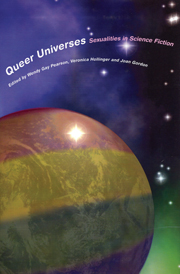Alien Cryptographies: The View from Queer
from Part I - Queering the Scene
Summary
Fiction, then, can be divided according to the manner in which men's relationships to other men and their surroundings are illuminated. If this is accomplished by endeavoring faithfully to reproduce empirical surfaces and textures vouched for by human senses and common sense, I propose to call it naturalistic fiction. If, on the contrary, an endeavor is made to illuminate such relations by creating a radically or significantly different formal framework… I propose to call it estranged fiction.
— Darko Suvin, Metamorphoses of Science Fiction 18Introduction: Fear of a Queer Galaxy
On November 25, 1998, the memberships of the USS Harvey Milk and the Voyager Visibility Project (offshoots of the lesbian and gay sf group, the Gaylaxians) issued a call for a boycott of the then soon-to-be-released Star Trek: Insurrection. After nearly two decades of lobbying the producers of the various Star Trek shows and movies for the inclusion of a lesbian or gay character in a cast intended to represent all types of humans (including a variety of racial and ethnic types, as well as both sexes) and quite a miscellany of aliens, the group's membership has finally, it seems, had enough. Curious as it might seem at first glance, sf shows seem to be the last hold-outs in a medium that is rapidly accommodating itself to the idea that there really are lesbian and gay people in the ‘real’ world that television claims, however peculiarly, to reflect (in precisely that mode that Suvin labels ‘naturalistic’).
- Type
- Chapter
- Information
- Queer UniversesSexualities in Science Fiction, pp. 14 - 38Publisher: Liverpool University PressPrint publication year: 2010
- 4
- Cited by



